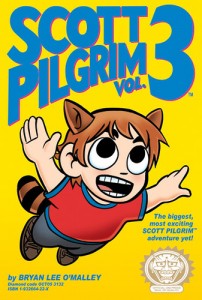Graphic Novel Review – Scott Pilgrim by Bryan Lee O’Malley
Hello. My name is John and I’m a male comic book fan from Toronto.... and, um, I don’t really like the Scott Pilgrim series of graphic novels.
I know, that’s total heresy to some people, but it’s true. I do not enjoy the series. Although I enjoyed the film starring local hipster hunk Michael Cera, I just can’t get into the graphic novels, try as I might. They’re just not my bag.
For the uninitiated: Scott Pilgrim is about the blossoming relationship between the titular hero and his American sweetheart Ramona Flowers. To win the day and the girl, all Scott needs to do is get a job, mature as a person and, oh yeah, defeat her seven evil exes in fights to the death.
The books are heavily influenced by anime, comic books and especially video games. Scott’s band is called “Sex Bob-omb”, combining Tom Jones with one of the more obscure villains from the Super Mario games. There’s a lot to like in that concept, but it just never clicked for me.
This isn’t about going against the grain either. I’m not saying I dislike it just to fly in the face of indy scenesters everywhere. I was actually on board with the series pretty early on. In fact, when I was in undergrad I worked at a very large bookstore in downtown Toronto one of my co-workers was wild about Scott Pilgrim.
When she learned that I was a fellow comic book nerd she insisted I catch up on the series - at that point only three of the six books had come out – and so I dutifully bought the first volume (Scott Pilgrim’s Previous Little Life) and demolished it in about 30 minutes of dock-side reading at a cottage.
There was certainly a lot to like about the book. It had its funny moments, particularly the climactic battle with Matthew Patel, and the characters had some charm. As a young man in Toronto working in a mind-numbing retail job, I had some sympathy for Scott.
Unfortunately, it was also crowded with too many of Scott’s friends and peers, and O’Malley’s artwork wasn’t sophisticated enough to make it clear who was who. Characters bled together on the page and in my mind.
Also, although I could I identify with some aspects of his life, Scott is the kind of person I’ve got little patience for in real life. He’s directionless, insensitive and oblivious to his surroundings. His friends are huffy and prone to inexplicable bouts of anger while hating their dead-end jobs.
If they were real people, I’d go out of my way to avoid them.
So after that first book I gave up on the series and moved on. When inevitably confronted by a hysteric Pilgrim-fan - they are legion in Toronto’s Annex neighbourhood - I’d politely shy away from the subject and explain I was really behind on my reading.
But the film trailers grabbed my attention and I went to see the Edgar Wright-directed movie on opening weekend. After all, it’s a movie that prominently features my hometown and I’m a sucker for all things Toronto.
It was smart, fun and moved quickly. The acting, particularly Cera in the title role and Kieran Culkin as his roommate Wallace Wells, was sharp and witty. I loved it.
That experience, coupled with reports from many friends that the art and writing improved with each book made me think I should give the series a second chance. I borrowed the remaining volumes from the library -Wychwood Branch, a prominent location in the series - and see if the books could redeem themselves.
Well, they didn’t. I still didn’t really like any of the books.
Although I got a better handle on who all the characters were, many were still incredibly whiny. There were too many throwaway scenes, too many pages of Scott lying around on his couch in a sulk. Characters fly into rages for no apparent reason, storming off dramatically to prove their invisble point.
I hated that kind of histrionics when I was in my early 20s, and I’m not keen to re-live it in graphic novel form.
Don’t get me wrong, there are some positives in these books. As far as a coming-of-age story, Scott Pilgrim is very good. There is a real sense of maturation in our hero and he really does develop into a more sensitive and thoughtful person. His complex relationship with Ramona is handled by O’Malley with a deft touch and there is much to be learned from both of them.
The books are also occasionally entertaining. There are pages and scenes that are legitimately funny and seeing stores, restaurants and clubs that I’m intimately familiar with printed on the page never really got old. But all that isn’t enough to overcome some of the deep flaws in this series.
Bryan Lee O’Malley’s Scott Pilgrim series is a fine entry point to the world of graphic novels, but there are at least a dozen other books that a neophyte fan could start with that would be more satisfying. It’s probably best to just watch the Michael Cera movie and then seek out recommendations that are like the books.
Book Review – The Glass Castle by Jeannette Walls
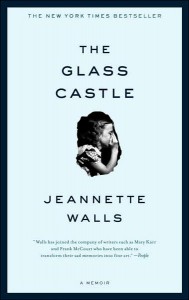 I never thought that I’d enjoy Jeannette Walls’ the Glass Castle, but I was wrong.
I never thought that I’d enjoy Jeannette Walls’ the Glass Castle, but I was wrong.
On the surface, it looked like it was more for stay-at-home moms. It was one of Heather’s Picks at Chapters-Indigo Bookstores and reeked of Oprah’s Book Club. But once I started reading it I appreciated Walls’ writing and was moved by her story.
Like Frank McCourt’s ultra-popular Angela’s Ashes, the Glass Castle is a dark memoir about a dysfunctional family crippled by the father’s alcoholism and the mother’s loose grip on reality.
The Glass Castle also follows a very similar format to Angela’s Ashes with each short chapter detailing an episode from the childhood of the author. More often than not these are horrible snapshots of poverty or struggle as the Walls’ household disintegrates.
These grim anecdotes are broken up by some funny stories from Jeannette’s childhood and the reader is buoyed up by the loyalty of her three siblings as they try to support each other and overcome their parents’ shoddy upbringing.
Walls’ writing is very good and although the subject matter is depressing and unsettling, she wisely injects some humour to create some balance.
What interested me the most was the social dynamics within the Walls household. Jeannette and her three siblings all independently come to the conclusion that their parents are unfit to raise them and that they need to take matters into their own hands.
Writing a compelling memoir is difficult. I’ve read many autobiographies that tell the author’s life story chronologically and from a single perspective. That’s a totally fair and natural way to structure a narrative, especially since an omniscient narrator would be some trick, but it’s obviously also quite limiting.
But Walls – a long-time journalist and former blogger with MSNBC.com – does well to flesh out the “characters” of her family and imply the feelings and motivations of each relative. This adds depth to her story that most autobiographies lack. The way her parents and sibling handles each situation is unquestionably real.
Walls is also a reasonably fair and balanced narrator. Her family might not be thrilled with their personal histories being exposed, but it’d be hard for any member of the Walls clan to say that Jeannette did them a disservice. She lets their actions speak for themselves and rarely puts words in their mouths.
Normally I would dismiss the Glass Castle out of hand. But Walls’ incredible storytelling abilities and the devastating circumstances of her childhood make this memoir a must-read for any fan of literature.
Graphic Novel Review: The Rocketeer: Complete Adventures by Dave Stevens
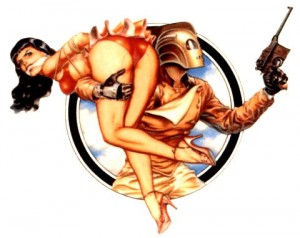 Sometimes it’s hard to articulate your feelings about a book or movie. Other times it just comes to you, like when I recently finished reading The Rocketeer: the Complete Adventures, a reprinting of Dave Stevens’ seminal series that was originally published n 1982.
Sometimes it’s hard to articulate your feelings about a book or movie. Other times it just comes to you, like when I recently finished reading The Rocketeer: the Complete Adventures, a reprinting of Dave Stevens’ seminal series that was originally published n 1982.
I found myself saying: “Really? That’s it?”
Not that it was a knock on the content of the book. The artwork is gorgeous and really pops thanks to the re-colouring done for this edition by Laura Martin. Stevens’ stories are good too, with some decent action as stunt pilot Cliff Secord learns to use a stolen jetpack and win back his best girl, Betty.
Stevens does an excellent job of building a sense of suspense, particularly in the second story “Cliff’s New York Adventure”. It’s a nice touch that he incorporated his hero into the Wold Newton Universe, having him work alongside the Shadow and with associates of Doc Savage.
But that’s the final story. There’s only two.
This was not what I was expecting, at all. As I made my way through the book I was waiting a third and final act that would match up with the ending of the 1991 film adaptation starring Billy Campbell and Jennifer Connelly. That climax never comes.
Instead, the Complete Adventures end with Secord leaving New York City for Los Angeles, with the expectation that he’ll be reunited with his girlfriend Betty. There should be another third to this book, but it just ends on that note. It’s an anti-climactic end to an otherwise enjoyable book.
I guess that’s the rub: those first two stories really are great. They’re fun and pulpy and in many ways are like Alan Moore’s Tom Strong.
But with any of the Tom Strong books there’s a sense that these are just a few of hundreds if not thousands of stories, and theyère much more detailed and fulfilling. The Rocketeer leaves you hanging.
It’s a shame that there wasn’t more to the series, and even worse, there never will be since Stevens passed away in 2008.
All in all, The Rocketeer: the Complete Adventures is a fun read and it has gorgeous artwork, but it’s disappointing that it’s so short and, ultimately, feels incomplete. It's a great concept, I just wish there was more of it.
If you’d like to read a second opinion, I’d recommend Chris Sims’ review of the Complete Adventures from December 2009.
Book Review: Bullpen Gospels by Dirk Hayhurst
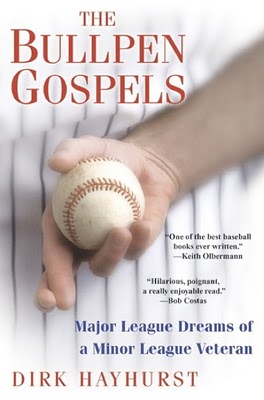 Halfway through Dirk Hayhurst’s Bullpen Gospels it occurred to me that I was reading one of the best books on baseball, ever.
Halfway through Dirk Hayhurst’s Bullpen Gospels it occurred to me that I was reading one of the best books on baseball, ever.
That’s some strong talk, particularly for someone who hasn’t read the entire baseball canon. But I’m getting there - just about every other book I read is about baseball.
I’ve devoured Jim Bouton’s Ball Four more than five times, I loved John Feinstein’s Living on the Black and Michael Lewis’ Moneyball. Also, as fans of this blog know, I’ve reviewed the graphic novel Satchel Paige:Striking Out Jim Crow as well as Sports Illustrated’s Great Baseball Writing.
The Bullpen Gospels slot in right above all of those, including Ball Four, my previous titleholder.
They’re comparable books too. Both are written by professional baseball players who find themselves pitching long relief in a bullpen full of odd characters. Yes, Bouton was an established major leaguer trying to master the knuckleball while Hayhurst, at that point, was a career minor leaguer in the San Diego Padres organization, but they’re still pretty similar books.
Bouton’s book is infamous for exposing the real lives of baseball heroes like Carl Yastrzemski and Mickey Mantle at a time when they were idolized by most fans. The aging Seattle Pilots reliever took a lot of heat for the book, with many people saying Bouton was a gloryhound. I don’t agree with that sentiment, but it certainly reads like an expose.
Love it or hate it, Ball Four is a hilarious and insightful read. But, by contrast, the Bullpen Gospels is a much more genuine and sensitive story.
Starting with Hayhurst’s truly dire home life with an unbalanced grandmother and a fractured family crippled not by one, but two, alcoholics you immediately feel for the young reliever. When he moves on to spring training and the minor leagues you can’t help but appreciate his sense of humour.
Perhaps the most noticeable difference between Hayhurst and Bouton is that the former rarely criticizes his teammates or the Padres’ executives. On the few occasions when he does speak poorly of someone, it is a reasonable and measured critique, and he shies away from dropping big names for the sake of glamour.
The only person Hayhurst is really hard on is himself.
Gospels is a quick read that makes its way through an entire baseball season, with a truly joyous ending. It also imparts a better understanding of what life in the minors is like for aspiring ballplayers. Hayhurst is an effortless and charming writer. He’s likeable and always sincere in his beliefs.
I’d recommend this book to anyone, particularly as a companion to Jim Bouton’s Ball Four.
Book Review: Gretzky’s Tears by Stephen Brunt
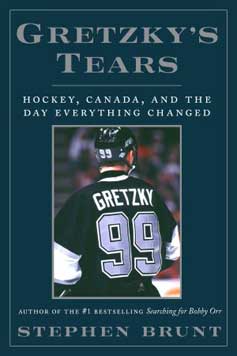 Gretzky’s Tears is the latest book by the Globe and Mail’s Stephen Brunt. It examines the controversial trade of Wayne Gretzky from the Oilers to the Los Angeles Kings, almost bringing an end to Edmonton’s Stanley Cup dynasty and launching the National Hockey League’s sputtering Sunbelt Expansion.
Gretzky’s Tears is the latest book by the Globe and Mail’s Stephen Brunt. It examines the controversial trade of Wayne Gretzky from the Oilers to the Los Angeles Kings, almost bringing an end to Edmonton’s Stanley Cup dynasty and launching the National Hockey League’s sputtering Sunbelt Expansion.
Brunt is one of Canada’s foremost sports journalists, and one of the best “big picture” writers in the newspaper business today. Unfortunately, Gretzky’s Tears does not meet Brunt’s usually high standards, particularly in contrast to his own body of work and other media on the subject.
The closest comparison is Brunt’s previous book, Searching for Bobby Orr, which I reviewed on my old blog . Indeed, in the Acknowledgements section of Gretzky’s Tears Brunt says that it was intended as a sequel to Searching.
Both books spotlight the greatest hockey player of their generation, both address the theme of innocence lost and both subjects shy away from the limelight. Orr was always intensely private and Gretzky is big on controlling his own public image.
As a result, Brunt was unable to interview either player for his books. Instead, he focuses on interviewing the people around Gretzky and Orr, painting a picture of the circumstances and personalities surrounding these prominent Canadian figures.
It was a very effective method in Searching for Bobby Orr, but falls flat in Gretzky’s Tears.
The difference is that Orr’s entourage has maintained an omerta-like silence around the former Boston Bruin. Even former business associates like Alan Eagleson and Harry Sinden, both of whom have fallen out with Orr, did not participate in Brunt’s research for Searching.
However, in Gretzky’s Tears, two of the principals in the trade, former Oilers owner Peter Pocklington and former Kings owner Bruce McNall, submitted to extensive interviews. The result comes across as a rather jaundiced account of the deal. Pocklington and McNall (and to a lesser extent former Edmonton General Manager Glen Sather) all get to say their piece, wheras Brunt, and therefore the reader, are left to guess at Gretzky’s state of mind before and after the move.
This would be fine if Gretzky’s Tears was created in a vacuum.
Unfortunately for Brunt, Pocklington wrote (with the help of Terry McConnell and J’Lyn Nye) a book of his own called I’d Trade Him Again that includes a forward by the Great One.
Worse yet, ESPN’s 30-for-30 documentary Kings Ransom also looks at the trade and filmmaker Peter Berg spoke extensively with Gretzky.
A smaller problem with the book is that it seems as though the editors backed off of Brunt’s copy. This might be because of the success of Searching for Bobby Orr, but Gretzky’s Tears suffers without a firm guiding hand.
The first chapter of Gretzky’s Tears is a ponderous exploration of loss of innocence that could have been cut completely. Further, Brunt has, for whatever reason, begun to copy sentences from one chapter to the next almost verbatim.
For example, towards the end of the book Brunt discusses Canada’s Olympic gold medal in 2002 and the rousing speech Greztky made at a press conference early in the games.
“[Gretzky] suggested that Canada was all alone, that the rest of Planet Hockey wanted it to fail, that it was us against the world. Standing in the room listening to him that day, it was difficult to tell how much was honest emotion, how much was a contrived attempt to inspire his team.” (p. 245)
Interesting commentary, except that just 45 pages earlier Brunt had described the same incident:
“Gretzky without prompting launched into a tirade – spontaneous or contrived – about how the whole hockey world wanted Canada to lose, it became a natural call to arms for both the country and the players.” (p. 200)
I only used excerpts, but aside from sentence structure the passages are almost identical.
It’s not an isolated incident either. There are several paragraphs throughout the book that repeat information and use similar phrasing. It’s a distracting habit and one that Brunt or his editor should have picked up on.
And that is the most disappointing thing about this book.
Stephen Brunt is an excellent writer who, in my opinion, is one of the best sports columnists in Canada. Searching for Bobby Orr was thoroughly researched and did a wonderful job of explaining the magic of Orr. On the other hand, Gretzky’s Tears is a flawed book that suffers by comparison to Brunt’s earlier work and the work of others.
By any other author this would be a solid book, but Brunt is a victim of his own success.
The Book Challenge
Three years ago, as a lark, I challenged my friends, family and co-workers to try and read as many books as they could in a calendar year. The idea was to encourage reading more and better books and broaden literary horizons.
As a group we laid out some general guidelines:
- Reading for work or for school doesn’t count. Books shouldn’t be assigned, but chosen for fun.
- Any book counts, as long as it’s for ages 9-12 or up. This designation was to allow for the Harry Potter books which fall into that age category.
- If you’re learning a new language books written for younger children count too.
- Graphic novels, plays, and poetry all count.
The Book Challenge, as it came to be called, was all about setting reading goals. Most people settled on 50 books per year (a book per week with two weeks of vacation). Smaller goals were also encouraged like “10 of my 50 books will be poetry,” or something to that affect. My personal caveat is that I only count 10 graphic novels per year. Otherwise I'd only read comics.
It’s been a pretty big success, with monthly reads discussed on our Facebook group. (Please, feel free to join!) Most people take it on as a New Year’s Resolution, but we have people coming and going all the time.
In part, the Book Challenge is popular because, unlike a book club, the reading isn’t assigned and you can move at your own pace. Also, it’s reassuring to see other avid readers apologize for not being able to read books for months at a time.
Last year I completed just 29 books, a disappointment since I’d planned on doing a full 50. But now that I’m done school I feel that I can definitely reach that golden mark.
I’m off to a good start as well, getting through four books in the month of January:
- On Writing by Stephen King
- Captain America: Winter Soldier vol. 2 by Ed Brubaker and Steve Epting
- Gretzky’s Tears by Stephen Brunt
- Satchel Paige: Striking Out Jim Crow by James Sturm and Rich Tommaso
Personally, I’ve found that the Book Challenge keeps me focused on maintaining on an ongoing reading list and motivated to keep plowing through it. And as Run DMC said, “From the front to the back, as pages turn, reading is a very fresh way to learn.”
Book Review: On Writing by Stephen King
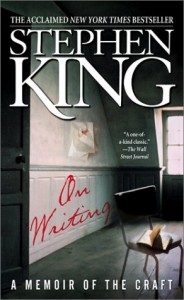 Stephen King’s On Writing is one of the best books I’ve read on how to become a writer. Not necessarily a professional scribe, but how any author can hone their craft until their work becomes readable and entertaining.
Stephen King’s On Writing is one of the best books I’ve read on how to become a writer. Not necessarily a professional scribe, but how any author can hone their craft until their work becomes readable and entertaining.
On Writing is full of King’s wit and charm as he explains how he builds his stories from the ground up. His encouraging voice is directed at fiction writers at the start of their careers, but his advice can be applied to anyone who wants to pursue their creative passion.
The book is divided into four parts: C.V., Toolbox, On Writing and then On Living.
C.V. is a short memoir that focuses on King’s life. As King says in the introduction: “This is not an autobiography. It is, rather, a kind of curriculum vitae – my attempt to show how one writer was formed,”
Some of the moments are tough to get through, particularly King’s upsetting history of drug and alcohol abuse. Fortunately, the entire section is spiked with his self-deprecating humour. Any fan of King’s work will enjoy reading this portion of the book.
Toolbox discusses the skills that every writer needs to be readable. Things like grammar, vocabulary, form and style. It’s the shortest part of the book, but still important and King, a former high school English teacher, makes it as entertaining as anyone could hope.
On Writing is the real meat of the book, where King explains how young writers should put their skills to good use. His ideas about drafting, story composition and research are all informative. In particular, I like how blue collar he is in his approach.
“[I]f you don’t want to work your ass off, you have no business trying to write well – settle back into competency and be grateful that you have even that much to fall back on,” King says in the introduction to the section.
According to King, his theories about writing and what it takes to succeed as an author are not popular with certain literary circles, but they appeal to me. Not just because it means there’s hope for the novice writer, but because I think that analyzing and honing one’s craft (whatever it may be) is the best way to succeed in any field. To see it applied to writing by one of the most widely read authors of the 20th century only confirms this.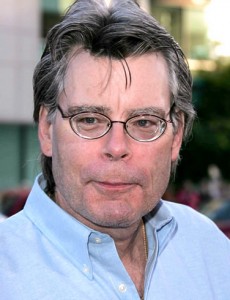
The entire tone of the book is light-hearted and informal, with King making funny asides and offering insight and commentary about his canon, as well as the work of an array of authors including Cormac McCarthy, Ernest Hemingway, Tom Wolfe, Elmore Leonard and H.P. Lovecraft.
In On Living, the book’s postscript, King recounts the events surrounding the car accident that nearly took his life during the composition of On Writing. I say ‘surrounding’ because he can’t remember the actual event – his head smashing through the oncoming windshield of a van took care of that.
It’s the most moving part of the book, and possibly the most stomach-turning writing of King’s accomplished career. His description of what happened to his body, particularly his right leg which was broken into “so many marbles in a sock”, literally had me squirming on my couch.
On Writing will appeal to two groups of people: Stephen King’s fans will be attracted to the C.V. and On Living sections where they can learn about their favourite author. Aspiring novelists will prefer the Toolbox and On Writing sections for King’s insight into his craft.
For everyone else though, it can still be a quick, fun read that will make them think twice about Stephen King and the art of writing.


